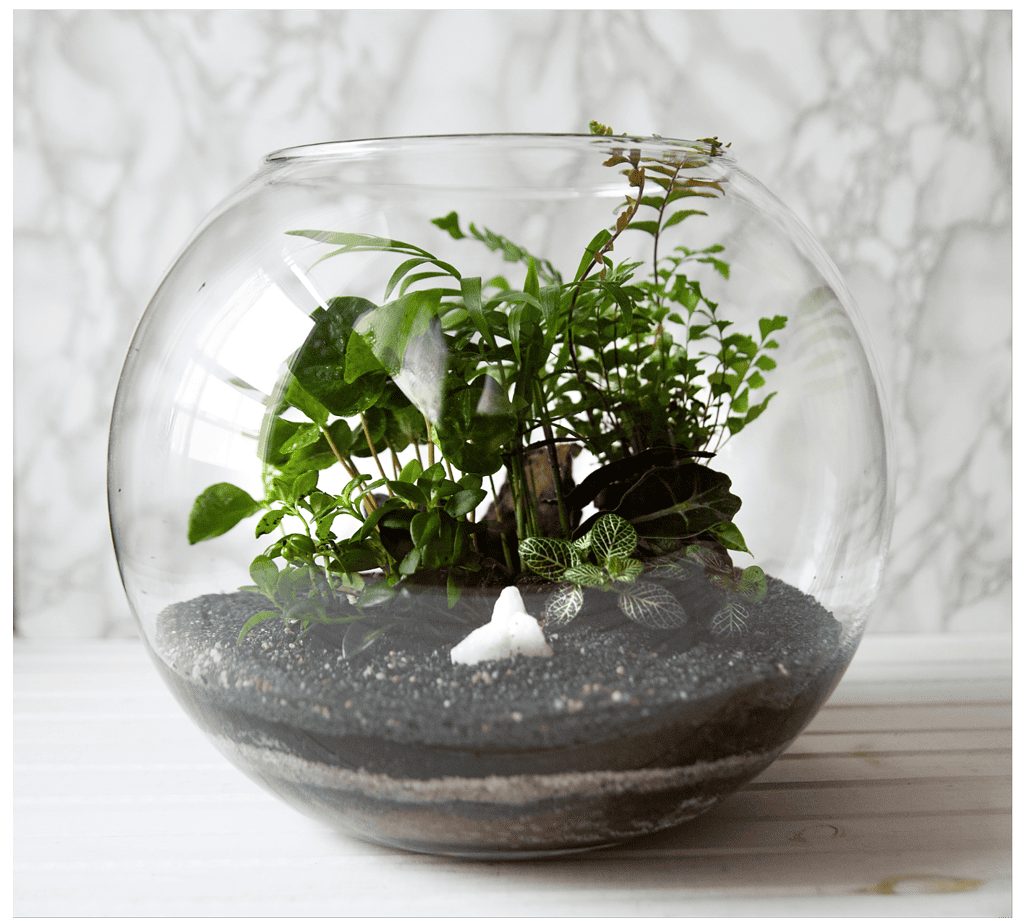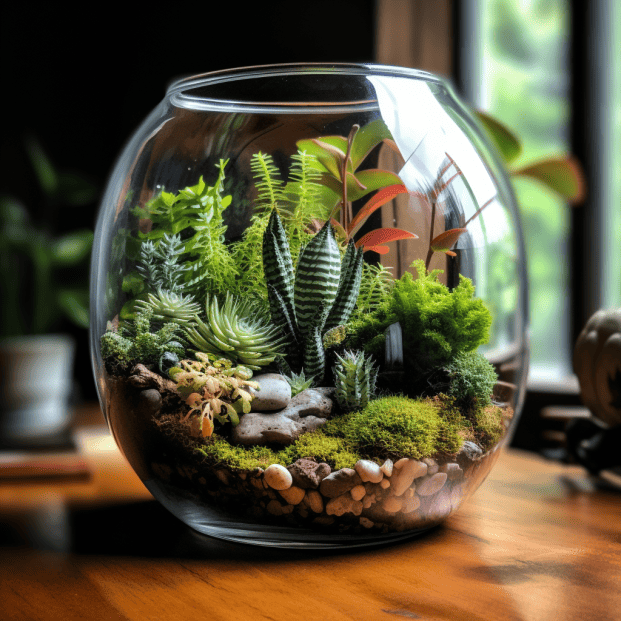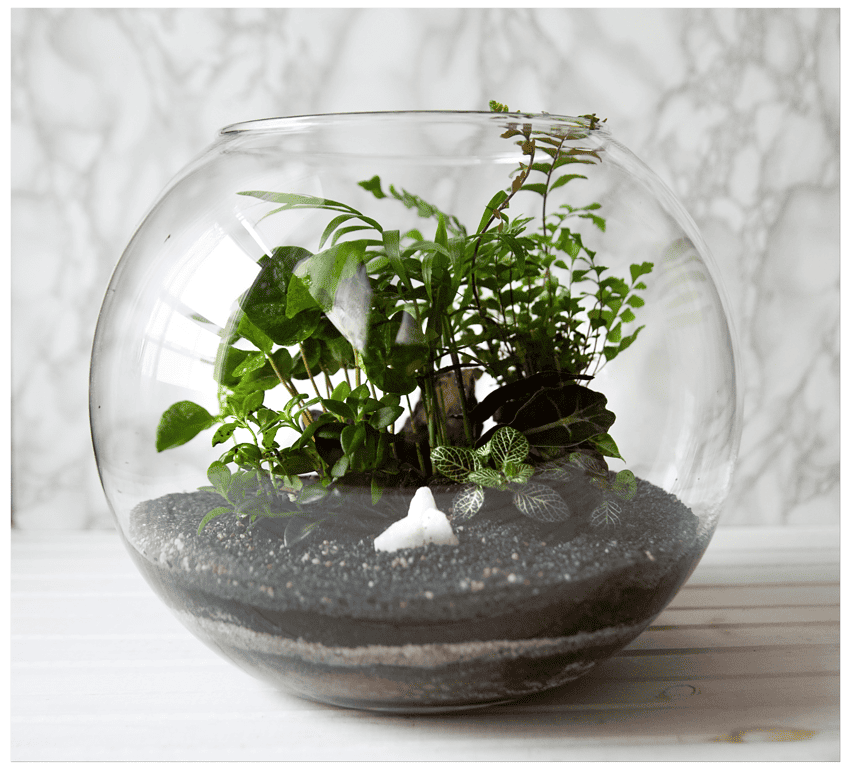Terrarium gardening for beginners provides an opportunity for plant lovers to create their own miniature ecosystems inside glass containers. These small, self-sufficient environments encapsulate the beauty of nature and bring it indoors, offering a captivating slice of the outdoors to those who may have limited outdoor space. Ideal for urban dwellers or anyone looking to add a touch of greenery to their living or working space, terrariums are decorative and require minimal maintenance once established.

A beginner’s guide to terrarium gardening encompasses the basics of selecting the right container, choosing compatible plants, and understanding the layering process essential for a healthy terrarium. The glass containers can range from simple jars to elaborate geometric shapes, each offering a unique canvas for creativity. Ensuring proper drainage, airflow, and light are also key elements that contribute to a thriving terrarium.
One of the joys of terrarium gardening is the wide range of plants that can adapt to this environment, from mosses and ferns to succulents and air plants. Each terrarium is a living art piece, a statement of one’s personal aesthetic and horticultural interests. With the right guidance, anyone can embark on this green journey, crafting a lush and vibrant oasis that showcases the wonder of miniature landscapes.
Understanding Terrariums
Terrarium gardening introduces a charming slice of nature indoors, creating a tranquil and picturesque miniature ecosystem within a compact glass container. This section covers the essentials of terrariums, spanning from their definition to the plants that best thrive in these self-contained environments.
Defining a Terrarium
A terrarium is a clear, usually glass container housing soil and plants, creating a miniature, self-contained ecosystem. It can be either sealed, known as a closed terrarium, offering a largely self-maintaining moisture cycle, or open to the air, aptly named an open terrarium, which requires more maintenance but can accommodate a greater variety of plants.
Benefits of Terrarium Gardening
Terrarium gardening boasts several benefits, including beauty, tranquility, and the practicality of requiring limited space. They bring a sense of nature indoors and can improve a room’s ambiance and air quality.
Types of Terrariums
There are mainly two types of terrariums:
- Closed Terrariums: Ideal for moisture-loving plants like ferns and mosses.
- Open Terrariums: Suitable for plants that prefer a dry climate, such as succulents and cacti.
Terrarium Components
Key components of a terrarium include:
- Rocks or gravel: For drainage.
- Activated charcoal: To keep water fresh and reduce bacteria and odors.
- Soil: Specific to the types of plants being grown.
- Plants: Chosen based on the type of terrarium.
Choosing the Right Container
A suitable container can be any clear glass or plastic vessel, from bowls and jars to specialized terrarium containers. The choice depends on whether the terrarium will be closed or open, size constraints, and aesthetic preference.
Plants Suitable for Terrariums
Terrarium plants vary based on the terrarium type:
- Closed: Ferns, mosses, and tropical plants that thrive in high humidity.
- Open: Succulents, cacti, and air plants that prefer less moisture.
- Carnivorous plants: Can also be included in both types, provided their specific needs are met.
Creating a terrarium is akin to crafting a living work of art. One can explore the enchanting world of terrarium gardening through Terrarium 101: A Beginner’s Guide to Creating Your First Terrarium, and learn about the various DIY steps through How to Make a Terrarium – A Beginner’s Guide (Step-By-Step). For a comprehensive understanding, The Complete Guide to Terrariums: From Basics to Expert Care offers an extensive overview, while ensuring the foundational layers are correctly laid out is detailed in Your One-Stop Terrarium Guide: All You Need to Know. Finally, tips for beginners are available through How to Start a Terrarium in 5 Easy Steps, simplifying the process into manageable actions.
Creating Your Terrarium
Creating your very own terrarium is an engaging project that involves designing a small, self-contained ecosystem. This section will guide you through each step, from gathering materials to the final assembly of your miniature garden.
Materials and Tools Needed
To begin your DIY terrarium, you will need the following items:
- Clear glass container
- Small stones or pebbles for drainage
- Activated charcoal to maintain freshness
- Potting soil suitable for the plants you’ve selected
- Sheet moss to create a barrier for the soil
- A variety of plants
- Gloves to keep your hands clean
- Spray bottle for watering
- Decorative elements like larger stones, bark, or driftwood
Layering the Foundation
Layering the foundation properly is crucial for a healthy terrarium. Begin with a pebbles or gravel drainage layer about 1-2 inches thick. Next, add a half-inch layer of activated charcoal. Top this with a piece of sheet moss to prevent the potting mix from mixing into the lower layers.
Plant Selection and Arrangement
Choose a diversity of plant varieties that thrive in similar conditions. Consider textures, colors, and varying heights to create visual interest. When arranging, place taller plants in the back and vary the placement of different textures and colors to maintain balance.
Adding Decorative Elements
Incorporate decorative elements like stones, driftwood, or bark to enhance the visual appeal of your terrarium. These should complement the plants, not overshadow them. If fitting, they can also serve a practical purpose, such as supporting plant roots.
Assembling Your Terrarium
Start by building your terrarium with the foundation layers and carefully adding your plant choices. Use tools if necessary to avoid disturbing the layers. Finish your terrarium by adding the hardscape and other decorative elements, ensuring that they’re arranged nicely. Carefully water your garden with a spray bottle, avoiding overly wet conditions, as closed terrariums retain moisture well.
Terrarium Maintenance
Proper maintenance is essential for a thriving terrarium. Balancing moisture levels, ensuring adequate light, and addressing any issues promptly can lead to a healthy mini ecosystem.
Watering and Moisture Management
Controlling watering and moisture levels is critical in terrarium care. Closed terrariums often create a self-sustaining environment where condensation indicates an active water cycle. One should ideally see a thin film of moisture on the glass, which suggests a good balance. Overwatering can lead to excessive condensation and potential mold growth, while underwatering could cause plants to dry out.
For open terrariums, periodic misting may be necessary to maintain humidity, especially in drier climates or during winter months when indoor heating can reduce air moisture. One may use a spritz bottle to gently mist the plants gently, ensuring the soil is moist but not waterlogged.
Light and Placement
Terrariums require sufficient lighting; however, they should be placed in indirect sunlight or indirect light to prevent overheating and potential harm to the plants. Direct sunlight can increase the internal temperature excessively, causing harm to the terrarium’s inhabitants. A location that receives bright, ambient light is ideal, simulating the dappled light of a forest floor. One must assess the light requirements of the specific plants within the terrarium and adjust positioning accordingly.
Long-term Care and Troubleshooting
Regular maintenance checks are vital for long-term terrarium health. Ongoing care includes pruning overgrown plants, removing dead foliage, and checking for signs of disease. Adjusting watering schedules or airflow may be necessary if moisture levels seem off. For closed terrariums, occasional airing can help refresh the environment, especially if condensation is too heavy and persistent. In case of mold or algae, one may need to remove affected areas and improve ventilation to prevent recurrence.
Advanced Terrarium Techniques

For those ready to elevate their terrarium gardening, advanced techniques can add sophistication and personal touch. From carefully curated scenes to specialized plant propagation, these methods will enhance your terrarium hobby’s beauty and engagement.
Creating a Theme or Scene
They can begin by selecting a theme that resonates with their personal aesthetic. Whether aiming for a whimsical fairy garden or a serene Japanese rock garden, attention to detail is key. Incorporate miniature figurines or scaled hardscape materials to anchor the theme. Remember to choose foliage and plants that complement the scene and thrive under similar conditions for a cohesive look.
Propagating Plants
Expert terrarium creators often use plant propagation to cultivate rare or special varieties within their glass gardens. They focus on plant root’s health and employ techniques such as leaf cuttings or division. A clear understanding of each plant’s growing medium needs is crucial for successful propagation in the confined space of a terrarium.
Innovative Terrarium Ideas
Innovative terrarium concepts break the mold of traditional glass container gardens. For instance, creatives are experimenting with open-air containers which can suit a wider variety of plants. Others are constructing hanging decorations from transparent materials that can host air plants or succulents, adding a dynamic element to their lifestyle photos and living spaces. These approaches invite avid gardeners to think outside the standard terrarium and integrate their creations into their daily environments in novel ways.
Incorporating Terrariums Into Your Home

Terrariums offer a unique combination of natural beauty and low-maintenance care, making them a fantastic addition to any living space. They enhance the aesthetic of a home while promoting an atmosphere of tranquility.
Displaying Terrariums
When introducing terrariums into the home, one should consider natural light sources and visual balance. For optimal growth, many terrarium plants require bright, indirect light. A common practice is placing terrariums near windows, though direct sunlight can be harmful. Thus, it might be advisable to position a terrarium on a side table or mantelpiece away from direct sun exposure. In terms of home décor, terrariums serve as living art and should be displayed where they can be appreciated for their intricate beauty. Bookshelves and coffee tables are ideal, as they allow for close-up admiration and lifestyle photos.
- Living Room: A large terrarium can serve as a centerpiece.
- Bedroom: Smaller, closed terrariums can be placed on nightstands, adding fresh air to the space.
- Office: A desk terrarium can offer a green, calming presence during stressful work.
Benefits of Terrariums in Home Décor
Terrariums are not just decorative elements; they contribute to a home’s ambiance. Their self-contained nature purifies the air, bringing fresh air and a sense of tranquility to indoor environments. Moreover, for those interested in aesthetic home improvements, terrariums provide a creative outlet to design and craft personalized landscapes. The care involved in maintaining a terrarium is modest and suitable for busy lifestyles, ensuring that even those with limited time can enjoy the benefits of indoor gardening. In this way, terrariums complement a modern home by coupling the loveliness of nature with convenience.
Terrarium Workshops and Community
Participating in terrarium workshops and engaging with online communities offers beginners tailored guidance and the support of fellow enthusiasts. These platforms provide easy-to-understand instructions and various resources to help newcomers embark on their terrarium gardening journey.

Finding Local Workshops
Local workshops are a treasure trove for beginners, usually organized by gardening stores or community centers. They provide step-by-step instructions and hands-on experience in crafting terrariums. The schedule and sign-up details are often listed on local business websites or community bulletin boards.
- Check local listings: Visit gardening centers or visit community websites for upcoming workshop announcements.
- Contact community centers: They often host or can guide you to the nearest terrarium-making sessions.
Joining Online Terrarium Forums
Online forums unite terrarium hobbyists from around the globe, facilitating a space to share knowledge and experiences. These forums are replete with tutorials, Q&A threads, and showcase sections for both novices and experts.
- Register on hobbyist sites: Sites such as Terrarium Tribe offer comprehensive guides.
- Engage on social platforms: Social media groups are easy finds for getting quick tips and sharing progress.
By tapping into these resources, beginners can enrich their skills and join the broader terrarium community both locally and online.
Frequently Asked Questions

As a beginner in terrarium gardening, there are several key questions that might come up. This guide provides straightforward answers to these queries to aid in creating a thriving terrarium.
How do you start a terrarium for beginners?
To start a terrarium, one must select a clear glass container with a wide opening. Begin with a foundation layer of stones for drainage, followed by a layer of activated charcoal to keep the environment fresh. Add a layer of potting soil and then carefully plant your chosen terrarium plants, making sure to space them out and plant them firmly.
What materials are needed to create a terrarium?
Creating a terrarium requires a few essential materials: a clear glass container, small stones or pebbles for drainage, activated charcoal, sphagnum moss (optional), potting soil appropriate for the plants you are using, the plants themselves, and decorative elements if desired. For tools, have a funnel, a spoon or scoop, and scissors or tweezers on hand.
What are the best plants to use in a terrarium for low maintenance?
Low maintenance plants ideal for terrariums include ferns, mosses, air plants, and succulents. These plants generally require minimal watering and are well-suited to the high-humidity environment of a terrarium. Ensure the plants you choose are compatible with each other in terms of their care requirements.
What is the proper layering sequence when assembling a terrarium?
When assembling a terrarium, the proper layering sequence starts with a base of small stones or pebbles to assist with drainage. This is followed by a layer of activated charcoal to help remove odors and toxins. Next, add sphagnum moss to act as a barrier before adding the soil layer. Finally, place your plants in the soil and add any desired decorative elements on top.
How often should a terrarium be watered and what is the best method?
Terrariums should be watered sparingly; the exact frequency varies based on the type of plants used. Generally, a thorough watering every two to four weeks is sufficient. Use a spray bottle or a dropper to water, aiming to moisten the soil without making it soggy. Monitor the terrarium’s humidity, as enclosed containers can trap moisture for extended periods.
What is the ideal location to place a terrarium for optimal plant growth?
The ideal location for a terrarium is a spot with plenty of indirect sunlight, as direct sunlight can cause overheating. Terrariums should be placed in a stable environment away from cold drafts and extreme temperature fluctuations to ensure consistent conditions for plant growth. Rotate the terrarium occasionally to ensure even light exposure and prevent plants from leaning toward the light source.


